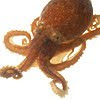
There are so many gorgeous moss-trimmed trees here in NC...it really makes me appreciate living in a wetter climate. But I DON'T like it when moss grows on our patio and house! Yes, just like the trees, the north side of our property grows moss. It could be lichen, but we'd have to ask my dad, the amateur lichen-lover, to verify.

I thought the moss was quaint at first, a sign that we'd really left the hot, arid Southern California climate. But the more it grows, the slipperier (more slippery?) it gets and the more it stinks, making our patio look like the Creepshow episode where that guy touched a meteor, then everything else he touched grew green fur until his entire house and body were covered in it....eesh!
So, the handyman said he could pressure-wash it for a fee. But we're done working with him because he's paranoid and constantly lectures us on how to fix our house (while he's fixing our house), and how to avoid being attacked by the enemy during battle. We thought about buying or renting our own pressure washer, but it's a little pricey. We've reserved our Christmas Lowe's gift cards for painting the living room.
Some people suggested bleach or vinegar - possibly inhumane and inefficient choices, respectively. In the end, we decided to buy a tub of OxyClean, mix it in a bucket of water, slosh the mixture all over the patio and house siding, and "power" spray it all with our own hose. The Portly Groundskeeper actually did all the hard labor while I napped.

The whole process took about an hour, and it actually worked pretty well! All the green moss is gone, bringing the patio back to it's normal non-life sustaining appearance. Some little bits of brown dirt-looking areas are still ground into the cement, so we're going to try the whole process again next week to see if we can improve the results. I've tentatively nominated myself for the job to be considerate.
As far as we can tell, there is no way to prevent this phenomenon from occurring, but we are looking into options such as anti-mold/mildew paint. We'll see.









